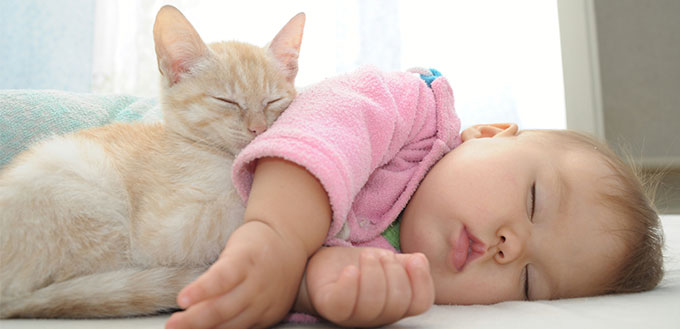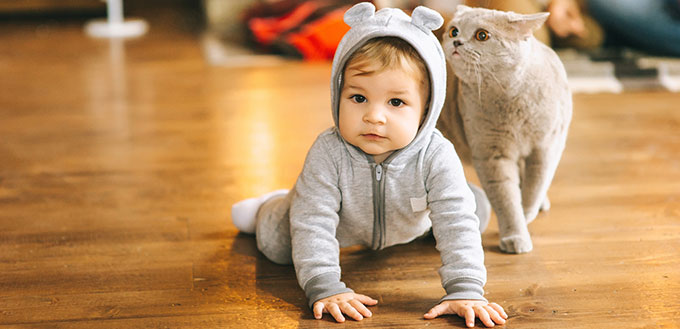When you find out that you are going to have a baby, there are a lot of changes that you have to make to your lifestyle and to your home. If you have pets, you also have to consider how you will prepare them for your new little bundle of joy. Cats need to be prepared for the arrival of a newborn and if you introduce your cat to a new baby in the right way, they could be pals for life.
Cats can be very sensitive to change and are naturally curious and territorial. So, cats and newborns can be a tricky combination. To try to make the process as stress-free as you can for everyone, check out our tips for introducing your cat to your baby.
Start Very Early!
The earlier you start the process the better. As soon as you find out that a new baby is on the way, you can start to make preparations. There will inevitably be changes to the physical environment of your home and the household routine. This will impact your kitty so it is wise to make some preparations. Once the baby arrives it is too late because you will be busy doing other things! Also, everyone in the household can play their part.
Think About How You Play With Your Cat
Get to know how your cat likes to be handled and what they dislike. Observe how your cat reacts when you touch their head, shoulders, stomach and tail. This will enable you to monitor what your baby does when they interact with your cat. If your kitty hates having their stomach stroked, you will need to carefully monitor your baby to make sure that they do not do that. Knowledge is power when it comes to keeping cats happy!
Do you let your cat grab and fight with your hands? This is sending a message that it is okay to be rough with parts of the human body. Avoid playing this sort of game as soon as you can and invest in some fun cat toys instead. Babies have very delicate skin and a bite or scratch from a cat during a game can cause a lot of damage and pain.
Baby Sounds, Odors and Equipment
Most babies make quite a lot of noise and it can startle a sensitive cat that is used to a quiet household. You can pave the way by playing recordings of a baby’s crying and gurgling for short periods. There will be plenty that you can use online. Start with the volume very low and gradually increase it as your cat gets used to the sound. Wait until your cat is calm and relaxed about a certain volume before you increase it.
Babies also have their own odor and come with a lot of ‘stuff’! Your cat needs to get used to all of this. Odors are very important to cats who like to give all new objects in the home a good sniff! They often view any new object with fear and suspicion. It would be a good idea to get some baby items into the house early on in the pregnancy. You could get some baby soaps, powders and shampoos and some baby milk. Put baby lotion on your own skin so that the new odors can mingle with the ‘safe’ odors that your cat is used to. It is also wise to get the larger items such as cots, pushchairs and changing mats in place before baby arrives but this can be later on in the pregnancy.
You can help even further by ‘scenting’ these new objects so that they are less distressing for your cat. Get a soft cloth and wipe it over your cat’s head to collect the scent from the scent glands. Then use it to wipe the new baby items. You could also use a special diffuser with a synthetic facial pheromone to reduce your cat’s stress levels as new things come into the house.
Create Special Cat Areas
A newborn baby may not be able to get to the cat’s food and water bowls but a toddler definitely will. So, the earlier you move it to a safe place, the better. Place it in a room or an area that can be cordoned off with a baby gate or pet barrier.
Cat’s also need a nice, quiet place where they can go to escape both the baby and the visitors that they inevitably bring. Your cat will prefer somewhere that is high up, dark and secluded. They also like to have a view of what is going on in the house. Some owners find that a tall scratching post with a high, covered over shelf is perfect. You can encourage your kitty into their safe space with some tasty treats and comfortable bedding. Ask visitors to ignore your cat when they are in their ‘safe place’.
You may have to change where your cat sleeps. Perhaps they currently use the spare room but you want to convert this to a nursery! If this is the case, you will need to gradually encourage kitty to sleep somewhere else and keep them away from their old sleeping place. This needs to be done a long time before the baby arrives as cats can take a long time to adjust.
You May Also Like: Cat Window Perches and Cat Scratching Towers
Take Kitty for a Health Check
The impending arrival of a new baby should remind you that kitty has health needs too! From a hygiene point of view, you need to make sure that they do not have any parasites that could cause your baby some health issues. Cat fleas and worms need to be eliminated!
Your kitty also needs a check over to make sure that they are well. Cats with on-going health conditions who do not feel well or who are in pain are often irritable and grouchy. Their tolerance to change and new family members will not be that great. They may even act aggressively. If you have any suspicions about your cat’s health, get them checked out before the new baby arrives.
Introducing Cat to Baby
It is not possible to accurately predict how cats and babies will react when they first meet each other. If this is not the first baby to arrive in the house, then your cat will probably have already made the adjustment and is more likely to take it in their stride.
First babies are a little trickier and you will need to make some decisions about how much access you will allow your cat to have. Do you want to exclude your cat from some rooms? Does your cat have behavioral problems that you need to be concerned about? Have you discussed this with your vet? You may need a referral to a pet behavior specialist.
When your cat first meets the baby, it should be at a quiet time and not the area of the house where your cat usually eats or sleeps. Let kitty approach you as you hold your baby. If they want to sniff the baby, you should reward them for being calm by giving them gentle praise and perhaps a tasty treat. It’s usual for a cat to lose interest after a few seconds. Other cats run away immediately. Never force an interaction as this is very stressful and counterproductive. Just carry on as normal and try another day.
Cats and Babies Health Risks
It is common for new parents to be concerned about cats and babies’ health risks. You may even be advised to rehome your cat by well-meaning but misguided friends and families. But are cats bad for babies? This is very rarely the case and if you are careful with hygiene, there is no reason to be worried.
Try not to leave used diapers on the floor as it can encourage your cat to use that area as a place to poop and pee. They figure that if a baby can do it, so can they! Always wash your hands thoroughly using antibacterial soap after you have fed, groomed or played with your cat. Wear gloves when you clean out the litter tray and wash them with antibacterial soap afterwards.
Even though cat toys and baby toys look similar, they are not the same thing and cats and babies should never share toys for hygiene and safety reasons.
You may also want to think about how to keep a cat out of crib. It helps if you do not place the crib or the baby on the floor. Even cats with gentle natures cannot be left unsupervised with a baby. You may want to get a screen door for the nursery or use a cot or pram net to protect your baby when they are sleeping.
Soon your household will calm down and cat and baby will love each other just as much you love them both!
Sources:
- Matt Wildman, Introducing Your Cat To Your New Baby, The Humane Society
- Cats and Babies, The ASPCA
- Sarah Lim, DVM, How to Prepare Your Cat for a New Baby, The MSPCA–Angell










